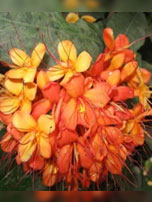SHAHEED KARTAR SINGH SARABHA AYURVEDIC MEDICAL COLLEGE & HOSPITAL
Affiliated to Guru Ravidas Ayurved University, Hoshiarpur Punjab
Affiliated to Guru Ravidas Ayurved University, Hoshiarpur Punjab

Botanical Name: Saraca asoca (Roxb.) DeWilde.
Family : Caesalpiniaceae
Introduction: We can see a clear description from Atharva veda parisita. This plant is known as friend of female also a good uterine tonic.
Synonyms: Kañkeli, Madhu puspa, Rakta pallava, Vanjulah, Hema puspa, Gatasoka, Ashoka, Ashoku, Hempushpa, Taamrapallava, Pindapushpa, Gandhapushpa, Saraca indica auct. non L
Classification according to Charaka, Susrutha & Vagbhata:
Charaka: Kasãya skañdha,Vedanãsthapana
Susrutha: Rodhrãdi
Vagbhata: Rodhrãdi
Varieties & adulterants – (CV – controversy, AD – adulterants):
It is being adulterated with the barks Polyalthia longifolia , Shorea robusta , Bauhinia variegate Cynometra travancorica – AD
Morphology:
It is a small ever green tree with drooping glabrous branches, 8-10 m. in height. Bark- with warty surface, dark-brown to grey or almost black
Leaves pinnate, 10-20 cm. long; leaflets 2-3 pairs, rigidly subcoriaceous, oblong or oblong- lanceolate.
Flowers- in dense axillary corymbs, fragrant, orange or orange-yellow, finally turning vermillion-red. Fruits- pods, flat, oblong, woody, about 8 x 20 cm.
Seeds- 4-8, ellipsoid oblong, compressed (Flowers in March-April and fruits in August- September).
Distribution & Habitat:
All over India, abundant in South India. The tree is found in abundance in Bengal and Burma. Cultivated about 700 m. above height
Chemical constituents:
Apigenin, O-beta-D-glucoside, cyaniding, diglucoside, kaempferol, pelargonidin-, diglucoside, quercetin, epicatechol, leucocyanidin, leucopelargonidin, procyanidin, derivatives, methyl-and ethylcholesterol, rhamnoside, amyrin, ceryl alcohol and beta-sitosterol.
Properties:
Rasa : Kasaya, Tikta
Guna : Laghu, Rüksa
Virya : Sita
Vipãka : Katu
Karma :
Pittahara, Hrdya, Varnya, Grãhi, uterine tonic, constipating, blood purifier.
Srotogamitva:
Dosha : Rapha, pittä kshayakarak.
Dhatus : Rakta (haemostasis), meda, rasayana. Mala : Purisha ( astringent), diuretic.
Organ : Uterus Ashoka is ‘specifically used for rakta-pradara is called a friend of women
Indication:
Gulma, udavartha, Apaci, Trisnã, Dãha, Krimi, Visaroga, Hrdroga, Rakta Pradara, Mutraghata, Asmari fever, burning sensation, visceromegaly, colic, leucorrhoea, piles, menorrhagia.
Part used: Stem bark, seeds, root
Dosage:
Leaf juice 10-15 ml Powder 2-4 g
Decoction 50-100 ml
External uses:
The bark has analgesic and antidotal properties. Hence its paste is used in pains and poisoning for local application.
Internal uses:
Nervous system : It has effect on the nerves and therefore is used in painful vata disorders.
Digestive system : Due to its astringent. anthetmintic and antidyspeptic prospective & it is useful in diarrhoea, dysentery, helminthiasis
Circulatory system It has haemostatic. blood purifying and antioedematous effects Hence 1t is used in diseases of the blood and oedema, its lowers are used in internal bleeding.
Reproductive system : It strengthens the muscles of the uterus and reduces uterine discharge and pain in the uterus and so it is useful in rnenorrhagia. leucorrheoa and dysrnenorrheoa Since the decoction of the bark acts as a tonic for the endometrium of the uterus, it is useful in many diseases of the uterus.
Urinary system : By virtue of its diuretic property, it is useful in dysuria and calculi, It prevents the formation of a calculus.
Temperature : It reduces the burning sensation frequently associated with pyrexia
Important Yogas or Formulations:
Asokaghrtam, Ashokarishta.
Therapeutic Uses:
1. Rakta Pradara- Cold milk boiled with the decoction of Asoka bark is useful.
2. Asmari-Seed powder of Asoka is administered with water.
